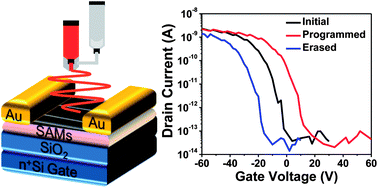Nonvolatile organic field effect transistor memory devices using one-dimensional aligned electrospun nanofiber channels of semiconducting polymers†
Abstract
We report the nonvolatile memory characteristics of organic field effect transistors (OFETs) using one-dimensional aligned electrospun (ES) nanofibers of semiconducting poly(9,9-dioctyl-fluorene-co-bithiophene) (F8T2). The effects of the nanofiber diameter associated with the polymer chain orientation on the charge transport and storage ability were explored. The OFET devices using the F8T2 ES nanofibers exhibited a large average memory window of ∼30 V, an on–off ratio of 102–103 and a hole mobility of 10−4 to 10−2 cm2 V−1 s−1. The write, erase and read processes of the memory device were performed by voltages across the nanofiber channels for at least 100 cycles and could be stabilized for at least 1000 s. The reversible hysteresis characteristics were attributed to the shallow trapping in the ordered/disordered domains of the F8T2 nanofibers from the in situ grazing incidence wide angle X-ray scattering (GIWAXS) analysis. Our results suggest that the semiconducting ES nanofibers could have potential applications for high performance OFET-based nonvolatile organic memory devices.


 Please wait while we load your content...
Please wait while we load your content...